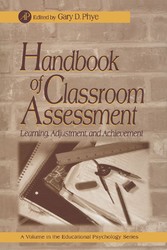Search and Find
Service
Front Cover
1
Handbook of Classroom Assessment: Learning, Achievement, and Adjustment
4
Copyright Page
5
Contents
6
Contributors
18
Preface
20
Part I: Assessment: Perspectives and Theory
24
CHAPTER 1. LEARNING, ACHIEVEMENT, AND ASSESSMENT: CONSTRUCTS AT A CROSSROADS
25
Learning and Achievement: Are They the Same?
26
Learning, Achievement, and Curriculum
29
Educational Reform and the Role of Assessment
31
Reconceptualizing Assessment
35
New Assessments for New Educational Outcomes
37
Classroom inferences about Learning and Achievement
41
Conclusions and Suggestions for the Future
52
References
53
CHAPTER 2. CLASSROOM ASSESSMENT: A MULTIDIMENSIONAL PERSPECTIVE
57
lntroduction
57
Teacher Competence
59
Assessment Options
64
Communicating Assessment Results
68
Frameworks for Assessment
69
Transfer as an Assessment Tool
73
Summary
74
References
75
CHAPTER 3. TEACHER ASSESSMENT LITERACY: WHAT DO TEACHERS KNOW ABOUT ASSESSMENT?
77
National Survey of Teacher Assessment Literacy
79
Discussion and Conclusions
91
References
91
CHAPTER 4. CLASSROOM ASSESSMENT AS INQUIRY
93
Teacher as Assessor: Where Have We Been and Where Are We Headed?
95
Teacher-Based Assessment of Student Achievement: A Scenario
97
Understanding the Example: A Conceptual Framework
102
Assessment as Inquiry
106
Back to the Future—and Ahead
119
References
123
CHAPTER 5. CLASSROOM ASSESSMENT OF REASONING STRATEGIES
127
Introduction
127
Some Common Conceptualizations of Problem Solving and Critical Thinking
128
A Framework of Reasoning Strategies
129
Examples of Reasoning Strategies in Content Domains and in Practical Situations
131
Implications for Assessment
133
Developing Classroom Assessments of Reasoning Strategies
137
Professional Development and Support
147
Evaluation of the Thinking Curriculum
153
Looking Ahead
153
References
154
CHAPTER 6. ACADEMIC SELF-CONCEPT: BEYOND THE DUSTBOWL
155
Introduction
155
The Structure and Measurement of Self-Concept
157
The Relationship of Self-Concept to Academic Achievement
172
The Influence of Frame-of-Reference Effects
179
Hierarchical Structure of Self-concept in Different Domains
197
Self-Concept Enhancement
201
Summary
215
References
217
CHAPTER 7. ASSESSMENT OF SUBJECTIVE WELL BEING DURING CHILDHOOD AND ADOLESCENCE
223
Introduction
223
Subjective Well-Being
224
Assessing Subjective Well-Being in Adults
233
Assessing Subjective Well-Being in Students
235
Part II: Standardized Assessment
251
CHAPTER 8. ASSESSMENT DURING THE PRESCHOOL YEARS
252
Introduction
252
Standardized Intelligence Tests
255
Screening Instruments
275
Conclusion
283
References
286
CHAPTER 9. THE ROLE OF STANDARDIZED ACHIEVEMENT TESTS IN GRADES K–12
290
Introduction
290
The Unique Challenges of Secondary School Testing
291
Usefulness of Standardized Achievement Tests
294
Interpreting Standardized Achievement Test Scores
300
Using Test Scores
308
Conclusion
310
References
310
Part III: Assessment of Classroom Learning
312
CHAPTER 10. A NEW VISION OF THE NATURE AND PURPOSES OF ASSESSMENT IN THE MATHEMATICS CLASSROOM
313
Introduction
313
The Changing Nature of School Mathematics and Mathematics Assessment
317
Forces Driving the Change in Assessment Practices
322
Promising Classroom Assessment Techniques
330
Theory o r Framework Building
336
Research Results
337
Issues for Debate
339
References
341
CHAPTER 11 . ELEMENTARY SOCIAL STUDIES: INSTRUMENTS, ACTIVITIES, AND STANDARDS
347
Introduction
347
Brief History of Assessment in Social Studies
348
The Present: A Broader View of Assessment and Evaluation
351
The Context for Developing a Comprehensive Social Studies Assessment Plan
352
Principles for Planning and Implementing Activities with an Eye toward Assessment
355
Authentic Assessment
363
Performance Assessment
365
Portfolios
367
Social Studies Standards: Links to Classroom Assessment
370
Guiding Principles for Creating, Monitoring, and Implementing Appropriate Social Studies Assessment Practices
370
Conclusion
371
Appendix
371
References
382
CHAPTER 12. AUTHENTIC ASSESSMENT IN SOCIAL STUDIES: STANDARDS AND EXAMPLES
385
Problem: Innovative Technique and Intellectual Quality
386
Authentic Achievement: Foundation for Standards
387
Authentic Assessment Tasks
392
Standards for Student Performance
398
How the Standards Can Help Teachers, Students, and Schools
402
References
405
CHAPTER 13. FOREIGN LANGUAGES: INSTRUMENTS, TECHNIQUES, AND STANDARDS
407
Historical Overview
407
Sample Assessment Instruments
412
National Standards and Assessment
436
Conclusion and Future Directions
439
References
439
CHAPTER 14. A USER-FRIENDLY GUIDE TO ASSESSMENT IN VISUAL ARTS
443
What Does Assessment Mean in the Visual Arts
443
Theory: What Is the Need for Assessment?
450
Assessment Consumerism
454
The New Art Basics System of Evaluation
460
A Model for Evaluating the Process of Visual Abstraction
465
Authentic Assessment of a Painting Class: Sitting Down and Talking with Students
468
Classroom Assessment Research
484
Authentic Classroom Assessment in an Inner City High School Program
498
References
504
Part IV: Developing Standards
507
CHAPTER 15. KINDERGARTEN THROUGH GRADE 12 STANDARDS: A PHILOSOPHY OF GRADING
508
Introduction
508
Components of a Grading System
511
Conclusion: From Principles to Practice
516
References
516
CHAPTER 16. USING PORTFOLIOS FOR LARGE-SCALE ASSESSMENT
518
Introduction
518
The Research Base
522
Potential for Portfolio Use in Large-Scale Assessment
539
References
541
CHAPTER 17. THE NATIONAL ASSESSMENT OF EDUCATIONAL PROGRESS
544
Subject Coverage and Assessment Instrument Development
547
Field Administration
549
Scoring the NAEP Exercises
550
The NAEP Database
550
Scaling
550
Interpreting NAEP Scales
552
Making the Population Estimates
553
Reporting
554
References
554
CHAPTER 18. EPILOGUE: CLASSROOM ASSESSMENT—LOOKING FORWARD
558
Introduction
558
Principles for Assessment
559
Professional Collaboration and Development
561
Meet the Authors
561
Conclusion
566
References
566
Index
568
All prices incl. VAT











